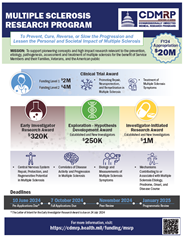Multiple Sclerosis
Vision – To prevent, cure, reverse, or slow the progression, and lessen the personal and societal impact of multiple sclerosis

» Click on Image to View Program Booklet

» Click on Image to View Strategic Plan

» Click on Image to View Program Overview
Multiple sclerosis (MS) is a degenerative, chronic, immune-mediated disease of the central nervous system that leads to cumulative neurologic disability over several years. The body's immune system attacks and damages certain structures and cells within the central nervous system, including the myelin (the fatty sheath that surrounds and protects nerve fibers), the oligodendrocytes (myelin-producing cells), and the underlying nerve fibers. This damage interferes with the transmission of nerve signals between the brain and spinal cord, and other parts of the body.
MS affects nearly 1 million individuals in the United States. While individuals of all ages are affected by MS, it is more commonly diagnosed in young adults, particularly women, between the ages of 20 and 40 years old.
MS is a heterogeneous disease that can manifest in many ways across the patient population. The progression, severity, and specific symptoms of MS are unpredictable and vary from one person to another. Currently, there is no cure for MS. The etiology and pathogenesis of MS were largely unknown until a recent Science magazine study demonstrated a strong correlation between Epstein-Barr virus (EBV) infection and onset of MS. This study opens up new avenues for the prevention and treatment of MS.
Since its inception in fiscal year 2009, the Multiple Sclerosis Research Program (MSRP) has supported innovative and impactful research that addresses fundamental issues and gaps in MS. The vision of the MSRP is to prevent, cure, reverse, or slow the progression and lessen the personal and societal impact of MS.
![]()
Congressional Appropriations
- $133.1 million
FY09-23 - $20 million
FY24

Funding
Summary
- 209 Awards in
FY09-23 - Recent Applications Recommended for Funding

Programmatic
Panels

Peer Review Participants
Last updated Monday, March 17, 2025














